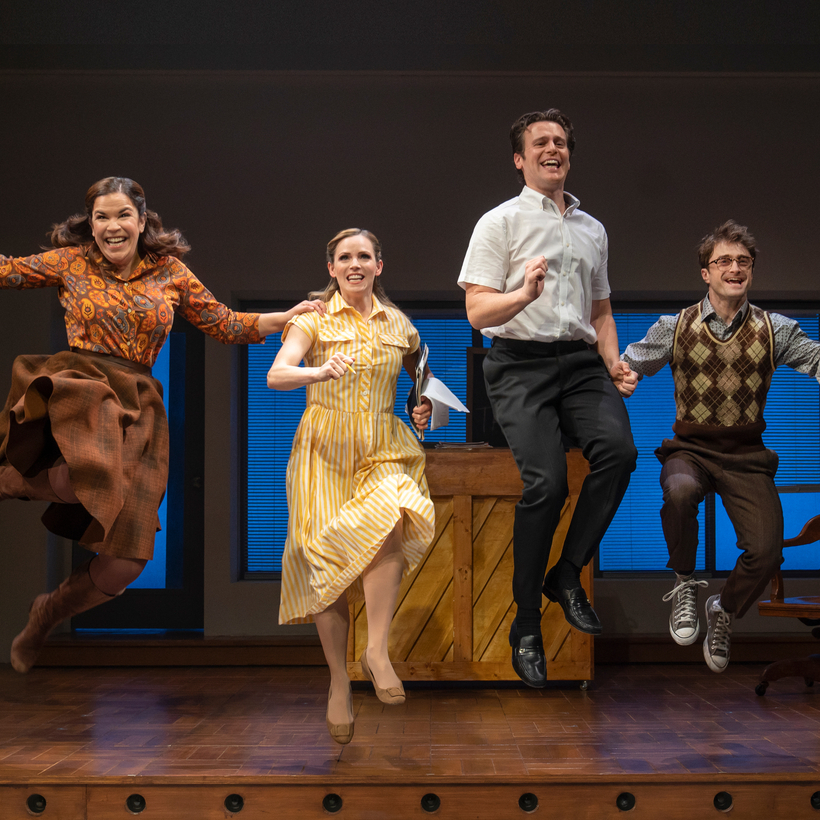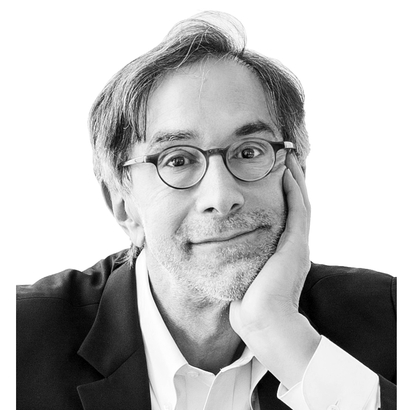I defy anyone lucky enough to get a ticket to the gorgeous, ideally cast, soon-to-be gone revival of Merrily We Roll Along not to start crying at the first a cappella notes of “Old Friends,” Stephen Sondheim’s rousing ode to the layered love that endures through all other relationships, familial or romantic—or should.
The director, Maria Friedman, has found the spontaneous, boundless joy in the bonds formed when we’re inventing ourselves, that moment when everything—achievement, recognition, fulfillment, love—lies before you. The love between the three friends at the center of the story—played by the wish-list trio of Jonathan Groff, Daniel Radcliffe, and Lindsay Mendez—leaps from the stage straight into the purest, yearning part of you that thinks the best still lies ahead. See why you’ll be crying?

The flaws that supposedly sank the show after only 16 performances at its 1981 Broadway debut started with a backward chronology that opens with the friends’ relationships in shards. As the scenes progress, we peel back the layers of cynicism and disappointment until the last scene, of the literally starry-eyed friends coming together for the first time on a rooftop at dawn to spot Sputnik.
Anyone curious to see how the show was originally presented can find a nearly two-hour recording on YouTube, with washed-out video and decent sound. I saw the original, and the problem, I remembered, and that the video refreshed, wasn’t that the plot was confusing. It’s that the first half-hour was so sour.

The host of the opening party, Frank, is a composer who has abandoned music and sold out to become a successful Hollywood producer. He claims to have everything he wants—he’s “Rich and Happy,” a number that was later cut—though he took a sledgehammer to the lives of the two friends who most loved and believed in him.
The problem wasn’t that the plot was confusing. It’s that the first half-hour was so sour.
The following scenes only reinforced what a callow jerk he is; and his two best friends were whiny wrecks. “Not much fun!” as the intoxicated writer Mary, a barely disguised Dorothy Parker, says she’s having in the opening exchange.
Five years after this dismal opening, Sondheim and the librettist, George Furth, went back to work on a new production, spurred by the director James Lapine, who had just collaborated with Sondheim on Sunday in the Park with George. (Lapine recently wrote a terrific book about its creation.) Aided by period-defining projections created by Lapine, whose first training was as a graphic designer, Furth and Sondheim jettisoned and streamlined characters and continued to clear up any confusion caused by the backward chronology. By the time Maria Friedman was cast as the Parker character, in a 1992 production in Leicester, Sondheim and Furth had said the show was where they wanted it.
Twenty years later, Friedman directed a production at the Menier Chocolate Factory, in London, that went a very long way toward solving the main problem: the hollowed-out, thoroughly dislikable man at the center. Friedman’s insight was to put the focus squarely on Frank, and to cast an appealing, seemingly guileless actor, Mark Umbers, who would make audiences understand how such an attractive character could go wrong.
Ten years later, she has doubled down by casting Jonathan Groff as Franklin—they don’t come any more likable—and Daniel Radcliffe as his stubbornly idealistic collaborator, Charley. Groff is a major U.S. stage-and-television star, having appeared in the original production of Hamilton and in the animated Frozen franchise. Radcliffe will always be a huge international star, thanks to Harry Potter; Mendez won a Tony for her delightful work in a Carousel revival. But all three fuse with their characters, and Friedman peels back the bitter anger to make us know how much they rely on, and plain want, each other.
I saw the understudy, Jamila Sabares-Klemm, at the matinee of the sold-out run at New York Theatre Workshop. Yet I can hardly imagine a more winning actor. She made me sympathize with and love her character, Mary, as no one has since the original actor, Ann Morrison. This is all the more impressive since Mary is an under-written part.

The wonder of the three is Radcliffe, who lands every laugh as Charley, the neurotic lyricist and playwright, often with a half-gesture or the lift of an eyebrow, or a sideways, understated reading that nails the line. His craft and marvelous comic timing make you believe him fully from the moment he appears—and forget everything and anything else about Radcliffe the star.
But all the actors love their characters and each other, and that love settles into you from the start. They spend the whole show longing to be together. You long for that, too, and to be united with your own best, least cynical self—open to change and willing, as E. B. White wrote in his great book Here Is New York, to be lucky.
Merrily We Roll Along is playing at New York Theatre Workshop until January 22, 2023
Corby Kummer is the executive director of the Aspen Institute’s Food and Society program. A senior editor at The Atlantic, he is also the author of several books, including The Pleasures of Slow Food: Celebrating Authentic Traditions, Flavors, and Recipes

